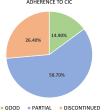Adherence of spinal cord injury patients in the community to self-clean intermittent catheterization (CIC) within 12 months of discharge following rehabilitation: A telephone survey
- PMID: 38819985
- PMCID: PMC12329841
- DOI: 10.1080/10790268.2024.2352931
Adherence of spinal cord injury patients in the community to self-clean intermittent catheterization (CIC) within 12 months of discharge following rehabilitation: A telephone survey
Abstract
Context: Spinal cord injury often results in neurogenic bladder affecting storage or emptying functions of the bladder. Clean intermittent catheterization (CIC) is considered the gold standard for patients with neurogenic bladder dysfunction. Our study aims to assess the adherence of patients to CIC following discharge from rehabilitation.
Objective: PRIMARY: To assess the adherence of patients with spinal cord injury in the community to self-CIC within 12 months of discharge. SECONDARY: To study the reasons and analyze the factors associated with discontinuation of CIC and to assess the perception of patients regarding CIC.
Methods: Prospective follow-up of a retrospective cohort in 121 individuals with paraplegia who were trained to do CIC for bladder management. After obtaining telephonic consent, a questionnaire-based interview was conducted.
Results: Out of 121 patients, 97 (80.2%) were males and 24 (19.8%) were females. The mean age was 35.8 ± 11.6 years. About 89 (73.6%) patients were continuing CIC as the primary mode of bladder management after discharge. However, only 18 (15%) patients were fully compliant with the CIC technique, 71 (59%) were partially compliant and 32 (26%) patients discontinued CIC. Reasons for the discontinuation of CIC included medical complications (78%), including leaks, recurrent UTI, hematuria, ulcers, back pain, and spasticity, and other factors like difficulty in following the timing of CIC (12.5%), issues with positioning (3.1%), and difficulty in restricting fluid intake (6.3%).
Conclusion: This study highlights the need for regular follow-up as well as education of patients regarding CIC technique, complications, care, and hygiene while doing CIC which can result in improved adherence to CIC.
Keywords: Adherence; Clean intermittent catheterization; Paraplegia; Spinal cord injury; UTI.
Figures
Similar articles
-
Factors affecting clean intermittent catheterization compliance among children and adolescents with neurogenic bladder due to spina bifida and caudal regression syndrome.J Pediatr Urol. 2024 Jun;20(3):481.e1-481.e9. doi: 10.1016/j.jpurol.2024.02.009. Epub 2024 Feb 15. J Pediatr Urol. 2024. PMID: 38413297
-
Quantifying guideline-discordant intermittent catheterization in adults hospitalized with spinal cord injury: a retrospective cohort study.Spinal Cord. 2025 May;63(5):270-276. doi: 10.1038/s41393-025-01078-w. Epub 2025 Apr 29. Spinal Cord. 2025. PMID: 40301533 Free PMC article.
-
Profile of patients practicing clean intermittent catheterization and associated resource consumption. Multicenter study in Spain.Actas Urol Esp (Engl Ed). 2025 Jul-Aug;49(6):501756. doi: 10.1016/j.acuroe.2025.501756. Epub 2025 Apr 21. Actas Urol Esp (Engl Ed). 2025. PMID: 40268085 English, Spanish.
-
Surgical management of functional bladder outlet obstruction in adults with neurogenic bladder dysfunction.Cochrane Database Syst Rev. 2014 May 24;2014(5):CD004927. doi: 10.1002/14651858.CD004927.pub4. Cochrane Database Syst Rev. 2014. PMID: 24859260 Free PMC article.
-
Probiotics for preventing urinary tract infection in people with neuropathic bladder.Cochrane Database Syst Rev. 2017 Sep 8;9(9):CD010723. doi: 10.1002/14651858.CD010723.pub2. Cochrane Database Syst Rev. 2017. PMID: 28884476 Free PMC article.
Cited by
-
Patient satisfaction, quality of life, and catheter-related complications in long-term urinary catheter users: a nationwide survey.World J Urol. 2025 Aug 1;43(1):470. doi: 10.1007/s00345-025-05850-8. World J Urol. 2025. PMID: 40748488 Free PMC article.
References
-
- Dev K, Das R, Vyas A.. Occurrence of urinary tract infection in reference to bladder-emptying method and etiological agents among spinal cord injury patients: a cross-sectional study. Indian J Phys Med Rehabil 2019 Mar 1;30(1):12–16.
-
- Lapides J, Diokno AC, Silber SJ, Lowe BS.. Clean, intermittent self-catheterization in the treatment of urinary tract disease. J Urol 1972 Mar;107(3):458–461. - PubMed
-
- Wyndaele J. Complications of intermittent catheterization: their prevention and treatment. Spinal Cord 2002 Oct;40(10):536–541. - PubMed
-
- Weld KJ, Dmochowski RR.. Effect of bladder management on urological complications in spinal cord injured patients. J Urol 2000 Mar;163(3):768–772. - PubMed
-
- Afsar SI, Yemisci OU, Cosar SNS, Cetin N.. Compliance with clean intermittent catheterization in spinal cord injury patients: a long-term follow-up study. Spinal Cord 2013 Aug;51(8):645–649. - PubMed
MeSH terms
LinkOut - more resources
Full Text Sources
Other Literature Sources
Medical
Miscellaneous


